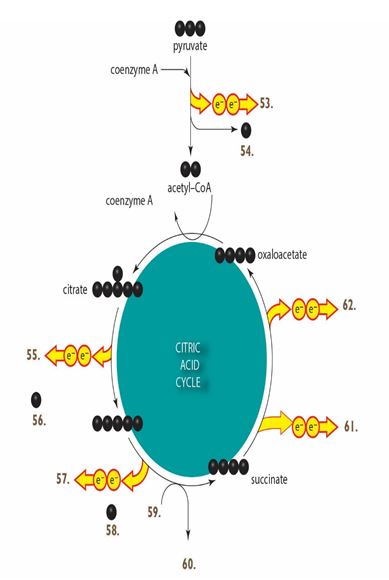A) NADP
B) pyruvate
C) NAD+
D) NADH
E) H2O
G) C) and D)
Correct Answer

verified
Correct Answer
verified
Multiple Choice
When molecules are broken apart in respiration,____.
A) the heat produced is used to drive biological reactions
B) the oxygen in the compounds that are broken apart is used as an energy source
C) the energy released is channeled into molecules of ATP
D) ATP is converted into ADP
E) ADP is released as a waste product
G) C) and D)
Correct Answer

verified
Correct Answer
verified
Multiple Choice
Labeling. Use these molecules to label the major inputs and/or outputs of the citric acid cycle on the figure below.Figure 7.8
 -What molecule corresponds to the item labeled as "58" in the accompanying figure?
-What molecule corresponds to the item labeled as "58" in the accompanying figure?
A) CO2
B) NADH
C) ADP + Pi
D) FADH2
E) ATP
G) D) and E)
Correct Answer

verified
Correct Answer
verified
Multiple Choice
Where in a cell does glycolysis occur?
A) Cytoplasm
B) Golgi body
C) Nucleoid
D) Mitochondrion
E) Rough endoplasmic reticulum
G) B) and E)
Correct Answer

verified
Correct Answer
verified
Short Answer
During alcoholic fermentation,____________________ is converted into ethanol.
Correct Answer

verified
Pyruvate
Correct Answer
verified
Multiple Choice
Labeling. Use these molecules to label the major inputs and/or outputs of the citric acid cycle on the figure below.Figure 7.8
 -What molecule corresponds to the item labeled as "62" in the accompanying figure?
-What molecule corresponds to the item labeled as "62" in the accompanying figure?
A) CO2
B) NADH
C) ADP + Pi
D) FADH2
E) ATP
G) A) and D)
Correct Answer

verified
Correct Answer
verified
Multiple Choice
During the citric acid cycle,____.
A) four CO2 molecules are produced
B) oxaloacetate is consumed
C) electrons and H+ are removed from the coenzymes NADH and FADH
D) molecules of carbon dioxide are consumed
E) oxidative phosphorylation occurs
G) B) and C)
Correct Answer

verified
Correct Answer
verified
Short Answer
Cells dismantle triglycerides by first breaking the bonds that connect fatty acid tails to _______.
Correct Answer

verified
Glycerol
Correct Answer
verified
Multiple Choice
Electron transfer phosphorylation yields ____ ATPs.
A) four
B) Two
C) Three
D) 32
E) Zero
G) D) and E)
Correct Answer

verified
Correct Answer
verified
Multiple Choice
The breakdown of ____ for energy production results in the formation of ammonia as a waste product.
A) carbohydrates
B) fats
C) proteins
D) carbohydrates and fats
E) fats and proteins
G) B) and E)
Correct Answer

verified
Correct Answer
verified
Multiple Choice
Which of the following is true regarding lactate fermentation in muscle cells?
A) It provides a quick burst of ATP.
B) It sustains muscle contractions during prolonged exercise.
C) It causes muscle soreness.
D) It is the predominant form of respiration in muscles.
E) Its products accumulate in muscle for extended periods of time.
G) D) and E)
Correct Answer

verified
Correct Answer
verified
Multiple Choice
In the breakdown of glucose,a phosphorylated six-carbon compound is split into two phosphorylated three-carbon sugars,which are named ____.
A) PGAL
B) pyruvate
C) acetyl-CoA
D) lactate
E) acetaldehyde
G) A) and C)
Correct Answer

verified
Correct Answer
verified
Multiple Choice
For animals,the final hydrogen acceptor in cellular respiration is ____.
A) NADP+
B) sulfur
C) oxygen
D) magnesium
E) phosphorus
G) A) and E)
Correct Answer

verified
Correct Answer
verified
Multiple Choice
Pyruvate is the end product of ____.
A) glycolysis
B) acetyl-CoA formation
C) fermentation
D) aerobic respiration
E) the citric acid cycle
G) A) and D)
Correct Answer

verified
Correct Answer
verified
Multiple Choice
Classification. Use the five compounds listed below for the following questions. -This compound is produced from acetaldehyde when it accepts electrons and a hydrogen ion from NADH.
A) Ethanol
B) Pyruvate
C) Lactate
D) Carbon dioxide
E) Acetaldehyde
G) None of the above
Correct Answer

verified
Correct Answer
verified
Multiple Choice
What is an anaerobic glucose-breakdown pathway that produces ATP without use of an electron transfer chain?
A) Cellular respiration
B) Fermentation
C) Glycolysis
D) Aerobic respiration
E) Anaerobic respiration
G) A) and B)
Correct Answer

verified
Correct Answer
verified
Multiple Choice
Select the one most appropriate choice for each. -Fermentation
A) Produces NADH and CO2; pyruvate oxidized
B) Produces ATP, NADH, and CO2
C) Splits glucose into two pyruvate molecules
D) Regenerates NAD+ as pyruvate is converted to ethanol or lactate
E) Uses a membrane-bound system that sets up production of ATP
G) None of the above
Correct Answer

verified
Correct Answer
verified
Multiple Choice
Classification. Use the five processes listed below for the following questions. -This process precedes the citric acid cycle.
A) Glycolysis
B) Aerobic respiration
C) Electron transfer phosphorylation
D) Alcoholic fermentation
E) Lactate fermentation
G) A) and D)
Correct Answer

verified
Correct Answer
verified
Multiple Choice
Aerobic respiration and fermentation ________.
A) evolved in different living organisms to utilize energy stored in glucose with equal efficiency
B) occur only in animal cells because plants carry out photosynthesis
C) utilize fat as primary energy source
D) occur at the same rate throughout all cells of the body
E) start with glycolysis.
G) C) and D)
Correct Answer

verified
E
Correct Answer
verified
Multiple Choice
Which of the following is not a product of the breakdown of dietary proteins for energy?
A) Amino acids
B) Ammonia
C) Pyruvate
D) Acetyl-CoA
E) Mitrate
G) A) and D)
Correct Answer

verified
Correct Answer
verified
Showing 1 - 20 of 75
Related Exams